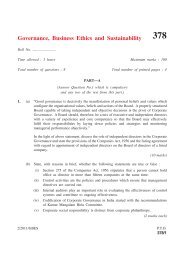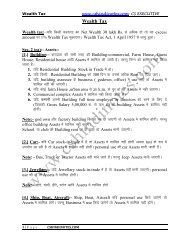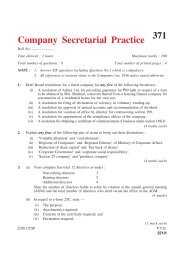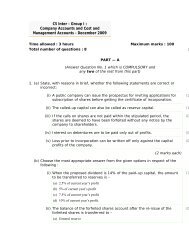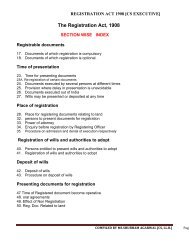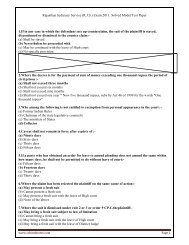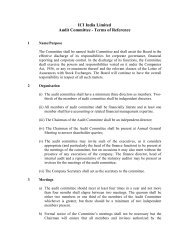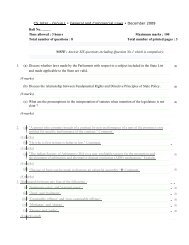SHUBHAM AGARWAL'S MCQ QUESTION BANK - cs notes
SHUBHAM AGARWAL'S MCQ QUESTION BANK - cs notes
SHUBHAM AGARWAL'S MCQ QUESTION BANK - cs notes
You also want an ePaper? Increase the reach of your titles
YUMPU automatically turns print PDFs into web optimized ePapers that Google loves.
<strong>SHUBHAM</strong> AGARWAL’S<br />
<strong>MCQ</strong> <strong>QUESTION</strong> <strong>BANK</strong><br />
PAPER 1 CODE A<br />
[ PARTA ] BUSINESS ENVIRONMENT<br />
1. bZ&dkWelZ ls vfHkizk; gSa &<br />
¼v½ bathfu;fjax dkWelZ ¼c½ bdksuksfeDl dkWelZ<br />
¼l½ bysDVªksfud dkWelZ ¼n½ mijksDr esa ls dksbZ ughaA<br />
2. ykq Lrjh; m|ksxksa esa fofu;ksx lhek ---------------------- gS &<br />
¼v½ ,d djksM+ #i;s rd ¼c½ nks djksM+ #i;s rd<br />
¼c½ rhu djksM+ #i;s rd ¼n½ nl djksM+ #i;s rd<br />
3. lw{e i;kZoj.k esa 'kkfey ugha fd;k tkrk gS &<br />
¼v½ xzkgdksa dks ¼c½ izfrLikf/kZ;ksa dks<br />
¼l½ ekdZsfVx e/;LFkksa dks ¼n½ izkd`frd<br />
4. O;olk; ds vkfFkZd okrkoj.k dks izHkkfor djrs gSa &<br />
¼v½ vkfFkZd uhfr ¼c½ vkfFkZd iz.kkyh<br />
¼c½ vkfFkZd fodkl ¼n½ mjksDr lHkh<br />
5. uohu vkfFkZd uhfr kksf"kr gqbZ &<br />
¼v½ lu~ 1990 ¼c½ lu~ 1991<br />
¼c½ lu~ 2001 ¼n½ lu~ 1992<br />
6. fgUnw vfoHkkftr ifjokj dk izcU/k ---------------- }kjk fd;k tkrk gS &<br />
¼v½ lk>snkj ¼c½ ekfyd<br />
¼c½ dŸkkZ ¼n½ va'k/kkjd<br />
7. QeZ esa lk>snkjksa dk nkf;Ro gS &<br />
¼v½ lhfer ¼c½ vlhfer<br />
¼c½ nksuksa ¼v½ o ¼c½ ¼n½ mijksDr esa ls dksbZ ughaA<br />
8. ,dkdh O;kikj esa &<br />
¼v½ iw.kZ xksiuh;rk gSa ¼c½ xksiuh;rk ugha gSa<br />
¼c½ xksiuh;rk ukeek= dh gSA ¼n½ mijksDr esa ls dksbZ ughaA<br />
9. la;qDr fgUnw ifjokj O;olk; esa lnL;rk izkIr gksrh gSa &<br />
¼v½ vkosnu ls ¼c½ flQkfj'k ls<br />
¼c½ tUe ls ¼n½ buesa ls dksbZ ughaA<br />
10. futh dEiuh esa lnL;ksa dh vf/kdre la[;k gSa &<br />
CS FOUNDATION <strong>MCQ</strong>’S NEW SYALLABUS Page 1
<strong>SHUBHAM</strong> AGARWAL’S<br />
<strong>MCQ</strong> <strong>QUESTION</strong> <strong>BANK</strong><br />
¼v½ 10 ¼c½ 20<br />
¼c½ 50 ¼n½ 7<br />
11. lnL;ksa dks mfpr ewY; ij vkoklh; LFkku miyC/k djkuk ------------ dk mÌs'; gSa &<br />
¼v½ mRiknd lgdkjh lfefr ¼c½ miHkksDrk lgdkjh lfefr<br />
¼c½ vkokl lgdkjh lfefr ¼n½ _.k lgdkjh lfefrA<br />
12. lkoZtfud {ks= ds miØe os laxBu gSa ftudk LokfeRo ---------------- dk gSa &<br />
¼v½ la;qDr fgUnw ifjokj ¼c½ ljdkj<br />
¼c½ fons'kh dEifu;k¡ ¼n½ futh miØe<br />
13. ,d ljdkjh dEiuh og dEiuh gSa ftlesa ljdkj dks ml dEiuh dh pqdrk va'k iw¡th esa fgLlsnkjh ls<br />
de ughaa gSa &<br />
¼v½ 49% ¼c½ 51%<br />
¼c½ 50% ¼n½ 25%<br />
14. dEiuh ftldk O;olk; ;k mRiknu ,d ns'k ls vf/kd esa gksrk gS &<br />
¼v½ cgqjk"Vªh; dEiuh ¼c½ jk"Vªh; dEiuh<br />
¼c½ fons'kh dEiuh ¼n½ buesa ls dksbZ ughaA<br />
15. foŸkh; izcU/k esa 'kkfey fd;k tkrk gS &<br />
¼v½ fofu;ksx fu.kZ; ¼c½ foŸkh; fu.kZ;<br />
¼c½ ykHkka'k fu.kZ; ¼n½ mijksDr lHkh<br />
CS FOUNDATION <strong>MCQ</strong>’S NEW SYALLABUS Page 2
<strong>SHUBHAM</strong> AGARWAL’S<br />
<strong>MCQ</strong> <strong>QUESTION</strong> <strong>BANK</strong><br />
[ PART –B] LAW<br />
16 fuEu eas ls dkSulk dFku lgh gS %&<br />
(a) izLrko rFkk Lohd`fr nksuksa [k.Muh; gSa A<br />
(b) izLrko rFkk Lohd`fr nksuksa v[k.Muh; gSaA<br />
(c) izLrko [k.Muh; gS Lohd`fr v[k.Muh; gSaA<br />
(d) izLrko v[k.MUkh; gS ] Lohd`fr [k.Muh; gSaA<br />
17. D;k ,d okf"kZd lkekU; lHkk ,sls fnu gks ldrh gSa ftls dsUnzh; ljdkj }kjk lkoZtfud vodk'k<br />
kksf"kr fd;k x;k gS &<br />
(a) gk¡ ] ijUrq dsoy rc tc AGM dk uksfVl vodk'k kksf’kr djus ls igys fn;k x;k gks A<br />
(b) ugha] AGM, lkoZtfud vodk'k ds fnu ugha gks ldrh gS A<br />
(c) nksuksa (a) or (b)<br />
(d) dksbZ ugha<br />
18. tc ,d O;fDr viuh dkj dh pkfc;k¡ nwljs O;fDr dks nsrk gS ] rks ;g fdl izdkj dh lqiqnZxh gS<br />
&<br />
(a) okLrfod lqiqnZxh<br />
(b) yk{kf.kd \lqiqnZxh<br />
(c) jpukRed lqiqnZxh<br />
(d) mijksDr lHkh A<br />
19. 'X' }kjk 'Y' dks vius <strong>cs</strong>Vs ds tUefnu ij vkus ds fy, vkaef=r fd;k tkrk gS rFkk Y }kjk bl<br />
le>kSrs dks Lohdkj fd;k tkrk gSa A bl fLFkfr esa ;g vkeU=.k ,d le>kSrk gS vuqc/ka ugha gSa<br />
D;kasfd %&<br />
(a) bleas dksbZ izfrQy ugha gSaA<br />
(b) bldk m}s'; oS/kkfud lEcU/k cukuk ugha gS A<br />
(c) bleas dksbZ dkuwuu m}s'; ugha gS A<br />
(d) mijksDr lHkh A<br />
20 Hkkjrh; vuqca/k vf/kfu;e] 1872 dh fdl /kkjk esa le>kSrs dks ifjHkkf"kr fd;k x;k gS &<br />
¼d½ 2 (c) ¼[k½ 2 (e)<br />
¼x½ 2 (g) ¼k½ 2 (i)<br />
21. MOA esa nkf;Ro okD; dh vko';drk gksrh gS &<br />
¼d½ va'kksa }kjk lhfer dEiuh ds fy,<br />
¼[k½ xkj.Vh }kjk lhfer dEiuh ds fy,<br />
¼x½ va'kksa rFkk xkj.Vh nksukas }kjk lhfer dEiuh ds fy,<br />
¼k½ mijksDr lHkhA<br />
CS FOUNDATION <strong>MCQ</strong>’S NEW SYALLABUS Page 3
<strong>SHUBHAM</strong> AGARWAL’S<br />
<strong>MCQ</strong> <strong>QUESTION</strong> <strong>BANK</strong><br />
22. ,slk lk>snkj tks lk>snkjh le>kSrs esa izos'k ugha djrk gSa ysfdu QeZ esa lk>snkj ds dk;kZsa dks<br />
djrk<br />
gSA dgrs gSa &<br />
¼d½ fu"Øh; lk>snkj ¼[k½ izn'kZu }kjk lk>snkjh<br />
¼x½ lfØ; lk>snkj ¼k½ lg&lk>snkj<br />
23. le; dh lekfIr ls igys funs'kd dks gVkus ds fy, dkSulk izLrko ikl djuk gS &<br />
¼d½ fo'ks"k izLrko ¼[k½ lk/kkj.k izLrko<br />
¼x½ nksuks ¼d½ o ¼[k½ ¼k½ mijksDr eas ls dksbZ ughaA<br />
24. vi;kZIr dks"k dh fLFkfr esa pSd ds dishonour gksus ij ] pSd fy[kus ij pSd ls nqxquh jkf'k dk<br />
tqekZuk yxrk gS rFkk dksbZ ltk ugha nh tkrh gS ;g dFku gS &<br />
(a) lgh (b) xyr<br />
(c) v'kar% lgh (d) va'kr% xyr<br />
25. A rFkk B ,d dEiuh esa dsoy nks lnL; gSaA nksuksa dh lM+d nqkZVuk esa e`R;q gks tkrh gSa bl<br />
fLFkfr esa dEiuh dk lekiu gks tk,xk ;g dFku gS &<br />
¼d½ lgh ¼[k½ xyr<br />
¼x½ va'kr% lgh ¼k½ va'kr% xyr<br />
26. buesa ls dkSu vuqcU/k eas 'kkfey gksus okyk ,d i{k gks ldrk gS \<br />
(a) ,d vijk/kh ftls n.M fn;k x;k gks<br />
(b) ,d dEiuh<br />
(c) vo;Ld<br />
(d) mijksDr lHkh<br />
27. jftLVªs'ku ds le;] dEiuh ds jftLVkj dks Article of Association tek djkuk fdl&fdl<br />
dEiuh<br />
ds fy, vko';d gS&<br />
¼d½ izkbosV dEiuh] vlhfer dEiuh] xkjUVh }kjk lhfer dEiuh<br />
¼[k½ vlhfer dEiuh<br />
¼x½ va'kksa }kjk lhfer dEiuh<br />
¼k½ lHkh izdkj dh dEifu;k¡<br />
28. QeZ ds jftLVsª'ku ds izkFkZuk i= dks gLrk{kfjr fd;k tkrk gS %&<br />
(a) lHkh lk>snkjksa rFkk muds ,stsUVksa }kjk kksf’kr djus ls igys fn;k x;k gks A<br />
(b) vf/kdrj lk>snkjksa rFkk muds ,stsUVksa }kjk<br />
(c) lHkh lfØ; lk>snkjksa rFkk muds ,stsUVks }kjk<br />
(d) lHkh vo;Ld lk>snkjksa }kjk<br />
29. dEiuh dk vfLrRo gSa &<br />
CS FOUNDATION <strong>MCQ</strong>’S NEW SYALLABUS Page 4
<strong>SHUBHAM</strong> AGARWAL’S<br />
<strong>MCQ</strong> <strong>QUESTION</strong> <strong>BANK</strong><br />
¼d½ yEck ¼[k½ yxkrkj<br />
¼x½ LFkk;h ¼k½ lhfer<br />
30. ,d lk>snkj tc QeZ NksM+rk gS ysfdu lkoZtfud lwpuk ugha nsrk gS rks D;k lk>snkj lkoZtfud<br />
lwpuk nsus rd QeZ esa lk>snkj ds :i esa nk;h gSa &<br />
¼d½ lgh ¼[k½ va'kr% lgh<br />
¼x½ xyr ¼k½ dksbZ ugha<br />
31. ,d uhykehdŸkkZ }kjk v[kckj esa foKkiu fn;k tkrk gS fd fnYyh esa dk;kZy; ds QuhZpj dh fcØh<br />
gksxhA ,d nyky tks eqEcbZ esa jgrk gS og ml fcØh ds fnu rFkk le; ij fnYyh tkrk gS ysfdu<br />
uhykehdŸkkZ }kjk uhykeh dh fcØh esa ls QuhZpj gVk fn;k tkrk gSA nyky }kjk le; rFkk [kpksZa dh gkfu<br />
ds fy, uhykehdŸkkZ ij okn fd;k tkrk gS D;k og lQy gksxk &<br />
¼d½ gk¡ ¼[k½ ugha<br />
¼[k½ okn ugha dj ldrk ¼k½ dksbZ ughaA<br />
32. 'M' ,d jksxk.kq nwj djus okys ikmMj dk fVu 'B' dks <strong>cs</strong>prk gS A og tkurk gSa fd fVu dks fcuk<br />
fof'k"V lko/kkuh ls [kksyus ij ;g [krjukd gksxk ijUrq og 'B' dks psrkouh ugha nsrk A 'B' [krjs<br />
dh tkudkjh u gksrs gq, fVu [kksyrk gS rFkk Lo;a /kk;y gks tkrk gSA 'B' /kk;y gksus ds gtkZus ds<br />
fy, okn nk; djrk gS A D;k og lQy gksxk \<br />
(a) gk¡ ] foi.ku ;ksX; gksus dh 'krZ A<br />
(b) gk¡ ] eky ds [krjukd gksus ds fo"k; eas lwpuk nsus dk vk'oklu<br />
(c) gk¡ ] eky ds fdlh fof'k"V m}s'; gsrq m;qDrrk dk vk'oklu<br />
(d) gk¡ ] xq.koÙkk rFkk mi;qDrrk dk vk'oklu<br />
33. py lEifÙk eqnzk dks 'kkfey ugha djrh ijUrq _________ dks 'kkfey djrh gS &<br />
(a) jgfr;k rFkk va'k (b) kkl<br />
(c) Qly mxrh gqbZ (d) mijksDr lHkh<br />
34. ,d nqdku ij tc fdlh eky dks ml ij dher yscy yxkdj n'kkZ;k tkrk gS rks dgrs gS &<br />
¼d½ izLrko ¼[k½ izLrko dh Lohd`fr<br />
¼x½ izLrko dk vkea=.k ¼k½ dksbZ ugha<br />
35. ,d fofue; lk/; foys[k ] ,d vo;Ld dh fLFkfr esa gksrk gS &<br />
(a) O;FkZ (b) O;FkZuh;<br />
(c) oS/k (d) voS/k<br />
CS FOUNDATION <strong>MCQ</strong>’S NEW SYALLABUS Page 5
<strong>SHUBHAM</strong> AGARWAL’S<br />
<strong>MCQ</strong> <strong>QUESTION</strong> <strong>BANK</strong><br />
PART C<br />
ENTREPRENEURSHIP<br />
36 'Enterprede' ls vk'k; &<br />
¼v½ vf/kxzg.k<br />
¼l½ O;kikj esa izos'k djuk<br />
¼c½ izcU/k djuk<br />
¼n½ dksbZ ugh<br />
37. ,d m|eh esa fuEu esa ls dkSulh fo'ks"krk ikbZ tkrh gS &<br />
¼v½ ekufld ;ksX;rk<br />
¼c½ laizs{k.k ;ksX;rk<br />
¼l½ lgh mÌs';<br />
¼n½ mijksDr lHkh<br />
38. Innovation ds lkr fl)kUr fdlds }kjk fn;s x;s &<br />
¼v½ Schumpeter<br />
¼c½ Jacob Viner<br />
¼l½ Samuelson<br />
¼n½ Stove Jobs<br />
39. PESTLE Analysis, esa 'E' ls vk'k; &<br />
¼v½ Expansion<br />
¼l½ Environmental<br />
40. okrkoj.kh; fo'ys"k.k esas 'kkfey fd;k tkrk gS &<br />
¼v½ dsoy vkUrfjd i;kZoj.k dks<br />
¼l½ nksuksa ¼v½ o ¼n½<br />
¼c½ Economical<br />
¼n½ Ecological<br />
¼c½ dsoy ckg~; i;kZoj.k dks<br />
¼n½ dksbZ ughaA<br />
41 m|eh 'kCn dk mn~xe ------------------------------- ls gqvk gS&<br />
¼v½ ysfVu<br />
¼c½ Qzsap<br />
¼l½ teZu<br />
¼n½ bf.M;u<br />
42. fuEu esa ls dkSulk okrkojh; fo'ys"k.k dk ,d rjhdk ugha gS &<br />
¼v½ Swot Analysis<br />
¼c½ Industry Analysis<br />
¼l½ GE model<br />
¼n½ Pestle Analysis<br />
43. uo fuek.kZ eas dkSulk rRo 'kkfey ugha gS &<br />
¼v½ fo'ks"kK<br />
¼c½ fuekZ.k lksp<br />
¼l½ izksRlkgu<br />
¼n½ Lo{kerk<br />
44. dksbZ Hkh O;fDr tks Loa; ds fy, dk;Z djrk gS tkuk tkrk gS &<br />
¼v½ v|eh<br />
¼c½ izcU/kd<br />
¼l½ nksuksa ¼v½ o ¼c½<br />
¼n½dksbZ ugha<br />
45. LDC ls vk'k; &<br />
CS FOUNDATION <strong>MCQ</strong>’S NEW SYALLABUS Page 6
<strong>SHUBHAM</strong> AGARWAL’S<br />
<strong>MCQ</strong> <strong>QUESTION</strong> <strong>BANK</strong><br />
¼v½ Law division countries<br />
¼l½ Law Products entry<br />
¼c½ Less developed countries<br />
¼n½ Less developed countries<br />
46. --------------- izdkj ds m|eh }kjk dk;Z rFkk O;fDrxr thou nksuksa dk;kZsa dks ,d lkFk izcfU/kr<br />
fd;k tkrk gS &<br />
¼v½ Hero<br />
¼c½ Healer<br />
¼l½ Sustainer<br />
¼n½ Artiste<br />
47. ,d O;kikj dks izkjEHk djus ds fy, ---------------- vkSj ------------------ vuq Hko dh vko';drk gksrh<br />
gS &<br />
¼v½ bathfu;fjax $ foØ;<br />
¼c½ foØ; $ izcU/k<br />
¼l½ bthfu;fjax $ O;kikj<br />
¼n½ O;kikj $ fuekZ.k<br />
48. o`f) gS --------------- tcfd foLrkj gS ---------------<br />
¼v½ ckg~;] vkUrfjd<br />
¼c½ vkUrfjd] ckg~;<br />
¼l½ LFkSfrd] izkoSfxd<br />
¼n½ dksbZ ughaA<br />
49. miØe fo'ys"k.k ds vUrxZr ------------------ lwpuk dks 'kkfey fd;k tkrk gS &<br />
¼v½ izfrLi/khZ mRikn dk cktkj dk vkdkj ¼c½ iwfrZdrkZvksa dh o`f) nj<br />
¼l½ u, mRikn dk izos'k<br />
¼n½ vkfFkZd ifjfLFkfr<br />
50. O;kikfjd ;kstuk ds rRoksa esa 'kkfey fd;k tkrk gS &<br />
¼v½ ;kstukc) izfØ;k<br />
¼c½ izfØ;k laca/kh<br />
¼l½ nksuksa (v) o ¼c½<br />
¼n½ dksbZ ughaA<br />
CS FOUNDATION <strong>MCQ</strong>’S NEW SYALLABUS Page 7
<strong>SHUBHAM</strong> AGARWAL’S<br />
<strong>MCQ</strong> <strong>QUESTION</strong> <strong>BANK</strong><br />
PAPER 2<br />
[ PART –A ] BUSINESS MANAGEMENT<br />
51. Which of the following statement is not correct<br />
(a) Management is a goal‐oriented process (b) Management is a continuous<br />
process<br />
(c) Management is a dynamic process (d) Management is a rigid process<br />
52. Organizational objectives which management aims to achieve.<br />
1. Survival, profit & Growth 2. Employment & Pollution control 3. Compensation<br />
(a) Only 1 & 3 (b) Only 2<br />
(c) Only 2 & 3 (d) all of them<br />
53. Why is management called as ‘inexact science’<br />
Management is called as ‘inexact science’ because<br />
(a) It is a social science<br />
(b) It does not have principles<br />
(c) It does not possess all characteristi<strong>cs</strong> of a pure (exact) science<br />
(d) It includes artistic approach<br />
54. Unity of command is related to<br />
(a) Superiors and subordinates<br />
(b) Management and workers<br />
(c) Planned actions<br />
(d) Cooperation among employees<br />
55. Globalization means<br />
(a) Reduced role of public sector (b) Integration of economies<br />
(c) Lowering interest rates (d) Control of inflation<br />
56. Which one of the following is the importance of planning<br />
(a) Reducing uncertainty (b) identifying alternative critically<br />
(c) Developing leadership (d) selecting the most appropriate<br />
plan<br />
57. The basic role of strategy is to provide ‐<br />
(a) Setting procedure (b) Direction for action<br />
(c) Direction for motivation (d) Direction for control<br />
58. Which one of the following plans prescribes chronological steps for performing activities<br />
(a) Procedure (b) Rule<br />
(c) Policy (d) Method<br />
59. Degree of decentralization indicates<br />
(a) Degree of authority delegation (b) Degree of responsibility<br />
(c) Degree of risk delegation (d) Degree of accountability<br />
CS FOUNDATION <strong>MCQ</strong>’S NEW SYALLABUS Page 8
<strong>SHUBHAM</strong> AGARWAL’S<br />
<strong>MCQ</strong> <strong>QUESTION</strong> <strong>BANK</strong><br />
60 . Organization structure establishes relationships between<br />
(a) Organizational and environment (b) People, work and resources<br />
(c) Organization and society (d) Suppliers and customers<br />
61. Expand ISO<br />
(a) Indian Standard Organization (b) International Standard<br />
Organization<br />
(c) International Supply Ordinance (d) International Supply Ordinance<br />
62. In staffing function, which combination of activities in sequential order is correct<br />
(a) Recruitment, selection, training, placement<br />
(b) Selection, training, recruitment, placement<br />
(c) Recruitment, selection, placement, training<br />
(d) Recruitment, training, selection, placement<br />
63. Need hierarchy theory of motivation has been given by<br />
(a) Maslow (b) Fayol<br />
(c) Taylor (d) Koontz<br />
64. Which one of the following is not a financial incentive<br />
(a) Bonus (b) Provident fund<br />
(c) Co‐partnership (d) Challenging job<br />
65. Which one of the following is a step of controlling<br />
(a) Assessing personnel required (b) Taking corrective action<br />
(c) Assessing environment (d) Taking disciplinary action<br />
66. Encoding is related to<br />
(a) Converting message into symbols (b) Converting symbols into message<br />
(c) Transmitting message (d) Receiving symbols<br />
67. Grapevine is the form of<br />
(a) Formal communication (b) Channel of communication<br />
(c) Informal communication (d) Barrier to communication<br />
68. Which one of the following is a semantic barrier<br />
(a) Organizational policy (b) Lack of attention<br />
(c) Technical jargon (d) Status<br />
69. ______________ is a natural phenomenon. Many changes regularly take place in organization<br />
internally and externally as well.<br />
(a) Change (b) Risk<br />
(c) TQM (d) MBE<br />
70. Breakdown of machine, corrupted software and so on, gives rise to which crisis<br />
(a) Natural (b) Confrontation<br />
CS FOUNDATION <strong>MCQ</strong>’S NEW SYALLABUS Page 9
<strong>SHUBHAM</strong> AGARWAL’S<br />
<strong>MCQ</strong> <strong>QUESTION</strong> <strong>BANK</strong><br />
(c) Technological (d) Misdeeds<br />
[ PARTB ] BUSINESS ETHICS<br />
71. The society of Business Ethi<strong>cs</strong> was started in<br />
(a) 1950 (b) 1960<br />
(c) 1970 (d) 1980<br />
72. The idea of business ethi<strong>cs</strong> caught the attention of academi<strong>cs</strong>, media and business firms by<br />
the<br />
end of the<br />
(a) First World War (b) Second World War<br />
(c) Cold War (d) None of the above<br />
73. the fields which settled the discourse of business ethi<strong>cs</strong> .<br />
(a) Media (b) Business firms<br />
(c) Academi<strong>cs</strong> (d) Both (a) (b) & (c)<br />
74. _____is not a natural science but a creation of human mind .<br />
(a) Ethical Standard (b) Business Ethi<strong>cs</strong><br />
(c) Ethi<strong>cs</strong> (d) None of the above<br />
75. Business Ethi<strong>cs</strong> has a ______ application.<br />
(a) Universal (b) Natural<br />
(c) Practical (d) None of the above<br />
76. The legitimate criticism of business practices was attacked for infuning the “_____” of<br />
entrepreneurs.<br />
(a) Honesty (b) Integrity<br />
(c) Freedom (d) reputation<br />
77. The term ‘ Business Ethi<strong>cs</strong>’ came into common use in the year.<br />
(a) 1950 (b) 1960<br />
(c) 1970 (d) 1980<br />
78. When was EBEN commenced .<br />
(a) 1952 (b) 1962<br />
(c) 1982 (d) 1992<br />
79. The alternative names for code of conduct are .<br />
(a) Code of ethi<strong>cs</strong> (b) Code of practice<br />
(c) both (a) & (b) (d) None of the above<br />
80. _____is a set of principle and expectations that are considered binding on any person who is<br />
the member of a particular group .<br />
(a) Code of ethi<strong>cs</strong> (b) Code of Conduct<br />
CS FOUNDATION <strong>MCQ</strong>’S NEW SYALLABUS Page 10
<strong>SHUBHAM</strong> AGARWAL’S<br />
<strong>MCQ</strong> <strong>QUESTION</strong> <strong>BANK</strong><br />
(c) Code of practice (d) all of the above<br />
[ PARTC ] BUSINESS COMMUNICATION<br />
81. English has become the global language of business and finance”. Who spoke this line <br />
(a) john keats (b) Salman Rushdie.<br />
(c) Nayantara Sehgal (d) JM Keynes<br />
82. Which is not a proverb .<br />
(a) Sweet are the uses of adversity<br />
(b) To scatter to the winds<br />
(c) a rose would smell as sweet by any other name<br />
(d) A closed mouth catches no flies.<br />
83. find out the antonym of the word “meager”.<br />
(a) Empty (b) Plentiful<br />
(c) both (a) or (b) (d) Amnesty<br />
84 A job application is similar to<br />
(a) Sales letter (b) Purchase letter<br />
(c) Letter of order (d) None of the above<br />
85. Which of the following is not an importance of communication.<br />
(a) Human Relation (b) Inter‐disciplinary Science<br />
(c) Personal Asset (d) Public relation<br />
86. What does the idiom mean “to scatter to the winds”<br />
(a) To waste (b) Prove of something<br />
(c) To prejudice another person (d) to deteriorate badly<br />
87. What does OEM stands for :‐<br />
(a) out stated equipment manufacturers<br />
(b) Original Equipment manufactures<br />
(c) ordinary Equipment manufactures<br />
(d) None of these<br />
88. A commercial transaction is a ________ process .<br />
(a) Simple (b) chain<br />
(c) complex (d) None of the above<br />
89. Meaning of RSVP is<br />
(a) Please pay (b) Please send<br />
(c) Both (a) & (b) (d) Please reply<br />
90. What does intra personal communication mean.<br />
(a) Communication with ourselves (b) Communication with other<br />
(c) Both (a) & (c) (d) None of above<br />
CS FOUNDATION <strong>MCQ</strong>’S NEW SYALLABUS Page 11
<strong>SHUBHAM</strong> AGARWAL’S<br />
<strong>MCQ</strong> <strong>QUESTION</strong> <strong>BANK</strong><br />
91. Which is not a type of verbal communication.<br />
(a) Oral (b) Written<br />
(c) Visual (d) Gestures<br />
92. ______only mentions the quantity and type of good.<br />
(a) invoice (b) Performa invoice<br />
(c) Delivery challan (d) None of the above<br />
93. The Proverb “to rob peter to, pay paul” means<br />
(a) things take time to complete and to mature<br />
(b) to harm one person in order to benefit the other<br />
(c) you judge a man s worth by his clothes<br />
(d) A man is judged by sort of friends he has.<br />
94. ______request is to be made to depository participants with whom the shareholder has a<br />
demat account in the prescribed standard .<br />
(a) De‐materialization (b) Re‐materialization<br />
(c) De‐regulating (d) regulating<br />
95. Facial expression ; gestures Eye contact ; Nodding the head and physical appearance are<br />
the form of :<br />
(a) Verbal communication (b) Oral communication<br />
(c) Non verbal communication (d) Visual communication<br />
96. It is advisable to sent a copy of ________ showing arrears of payment to the companies<br />
before sending the collection letter.<br />
(a) Statement of account (b) Statement of affair<br />
(c) statement showing balance sheet (d) all of the above<br />
97. Which of the following is not a form of intra‐organizational communication.<br />
(a) Representation (b) memorandum,<br />
(c) Press release (d) office <strong>notes</strong><br />
98. What does office order do not include<br />
(a) Order No (b) Subject<br />
(c) Date (d) Under Signed<br />
99. What point should be avoided while writing a telegram .<br />
(a) Use of lower case (b) Use of AM and PM<br />
(c) Good use of grammar (d) both (a) & (b)<br />
100. Format of ‐‐‐‐‐ differ from company to company<br />
(a) office order (b) Memo report<br />
(c) Office Note (d) Office circular<br />
CS FOUNDATION <strong>MCQ</strong>’S NEW SYALLABUS Page 12


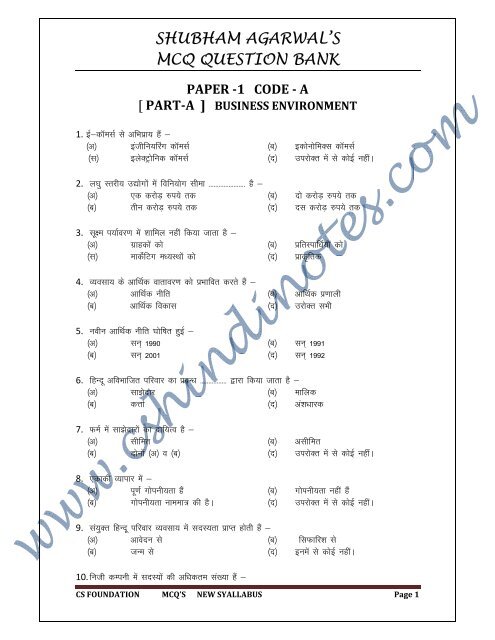
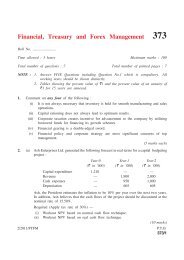
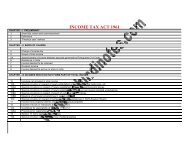
![vf/kfu;e dk vFkZ 'fu.kZ;' [ Interpretation of Statues ] Statue ... - cs notes](https://img.yumpu.com/38855798/1/190x245/vf-kfue-dk-vfkz-fukz-interpretation-of-statues-statue-cs-notes.jpg?quality=85)
